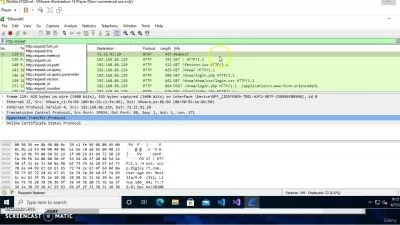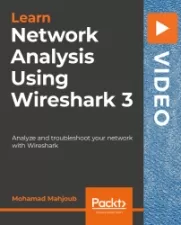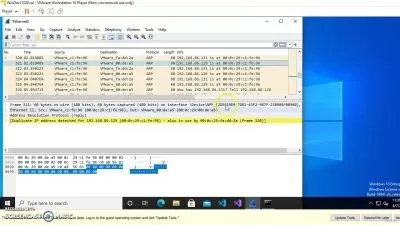Getting Started with Wireshark: The Ultimate Hands-On Course
Experts with David Bombal,Chris Greer,David Bombal
5:12:53
Description
Go from Packet Zero to Packet Hero with this Practical Wireshark course.
What You'll Learn?
- Capture and interpret network traffic with Wireshark
- Understand core networking protocols - DHCP, DNS, TCP/IP
- Troubleshoot the top five network problems with Wireshark
- Analyze a cybersecurity attack with Wireshark
Who is this for?
What You Need to Know?
More details
DescriptionWireshark can be intimidating. I remember how it felt when I first started looking at a trace file with Wireshark. Questions started flooding into my mind:
What should I look for? Where do I start? How can I find the packets that matter? What filters should I use? What is "normal" and what can I ignore in all this data?
I froze under the weight of all the detail in the packets.
If you have ever felt that way when looking at a pcap, this is the course for you!Â
Throughout this course, we are going to look at real-world examples of how to practically use Wireshark to solve network problems and isolate cybersecurity incidents. This skill will help all ITÂ engineers to improve in their analysis and troubleshooting skills. Assignments have been designed with participation in mind. Download the trace file, try your hand at the questions that go along with it, and see if you can solve the network mystery in the packets.
While learning the art of packet analysis, we will also explore the Wireshark interface, configure custom columns, filters, and coloring rules, learning how to customize the layout so we can spot problems fast. This course will give you comfort with the Wireshark interface and the experience you need to understand core protocols.
My name is Chris Greer and I am a Wireshark University instructor, as well as a packet analysis consultant for companies all over the globe. Like you, I started out looking at packet traces, hoping to find the right ones to solve complex issues on the network. I this course, I bring real-world examples to every lecture, exercise, and course assignment. My goal is for you to get comfortable with the Wireshark interface, learn to interpret the packets, and find actionable data that will help you to resolve problems or spot security incidents faster.
Ready Packet People? Let's dig!
Who this course is for:
- Network Engineers and Cybersecurity professionals who want to learn Wireshark
- Threat hunters who want to learn to dig into protocols.
Wireshark can be intimidating. I remember how it felt when I first started looking at a trace file with Wireshark. Questions started flooding into my mind:
What should I look for? Where do I start? How can I find the packets that matter? What filters should I use? What is "normal" and what can I ignore in all this data?
I froze under the weight of all the detail in the packets.
If you have ever felt that way when looking at a pcap, this is the course for you!Â
Throughout this course, we are going to look at real-world examples of how to practically use Wireshark to solve network problems and isolate cybersecurity incidents. This skill will help all ITÂ engineers to improve in their analysis and troubleshooting skills. Assignments have been designed with participation in mind. Download the trace file, try your hand at the questions that go along with it, and see if you can solve the network mystery in the packets.
While learning the art of packet analysis, we will also explore the Wireshark interface, configure custom columns, filters, and coloring rules, learning how to customize the layout so we can spot problems fast. This course will give you comfort with the Wireshark interface and the experience you need to understand core protocols.
My name is Chris Greer and I am a Wireshark University instructor, as well as a packet analysis consultant for companies all over the globe. Like you, I started out looking at packet traces, hoping to find the right ones to solve complex issues on the network. I this course, I bring real-world examples to every lecture, exercise, and course assignment. My goal is for you to get comfortable with the Wireshark interface, learn to interpret the packets, and find actionable data that will help you to resolve problems or spot security incidents faster.
Ready Packet People? Let's dig!
Who this course is for:
- Network Engineers and Cybersecurity professionals who want to learn Wireshark
- Threat hunters who want to learn to dig into protocols.
User Reviews
Rating
Experts with David Bombal
Instructor's CoursesChris Greer
Instructor's CoursesDavid Bombal
Instructor's Courses
Udemy
View courses Udemy- language english
- Training sessions 68
- duration 5:12:53
- English subtitles has
- Release Date 2022/11/20











